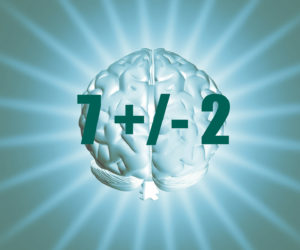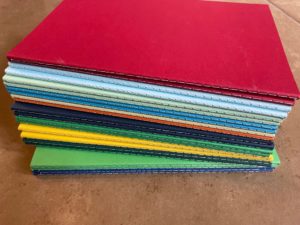
The Power of 7 +/- 2
(How Working Memory Works in Therapy)
How many things can you remember to get from the grocery store without writing it down? Well, never mind, I guess I already gave you the answer. Obviously, it’s 7+/-2. Or it is for most people.
And you probably learned about this in your intro psych class in college. But how is it meaningful in therapy, you ask?
It’s meaningful because your brain, and your clients’ brains, are pinball machines. You can really only hold about seven pieces of information in your brain at a time, and relatively small pieces of information at that. And they just “bounce around in there,” ad infinitum, unless we do something intentionally to get them out. And here are three ways that we can capitalize on this quirk of our brains in therapy.
#1: Journaling
I know that you already know that journaling is awesome. I know you could extol its benefits to almost any client, I know that you’ve seen it work its magic, maybe in your own life, and (because I’m a therapist, too) I also know that you sometimes recommend it for clients as homework just because you don’t know what other homework to give them. (We all do it!) And that’s OK, because journaling is pretty safe and, let’s face it, it sort of is magic. What you might not realize is how the 7+/-2 function of the working memory plays into the effectiveness of journaling, and how you might be able to use it even more intentionally and beneficially than you have been. One of the ways that we can get those bouncing pinballs inside our brains to get out is to write them down. I’m sure you’ve given this assignment to your anxious clients who have trouble getting to sleep at night because their pinballs are all the worries that they have about the next day. And you encourage them to put a pen and paper next to their bed, so that they can write down any anxious thoughts that they have or anything they need to remember for tomorrow, temporarily letting it go so they can sleep. Great!
Occasionally, that has unintended consequences. And you have a client who, instead of staying up for two hours thinking about the same five worries over and over, stays up for five hours writing down all the worries that came up after they wrote down the first five. And while they don’t like that very much, that’s part of the magic. When those five, seven, or nine thoughts keep bouncing around, they don’t leave any space for anything new. They don’t leave any space for other worries or concerns, and then those get kind of trapped, unexpressed, maybe even living inside and wreaking havoc on the client’s body. (More on this kind of thing in another post.) So they are not aware of, and cannot make you as their therapist aware of, all of their legitimate concerns. Journaling helps them to flesh all of those out. As if that weren’t enough, those seven pinballs also keep other new thoughts from coming in. Hopeful thoughts, new solutions, brilliant ideas, etc. So, one of the ways that we can take advantage of the 7+/-2 principal in therapy is to use journaling in a targeted way, whenever we want to give clients freedom to explore both the true breadth and depth of their concerns and also open them up to new possibilities.
#2: Healthy Conflict
Ok, how often have you had a couple in therapy and they’re discussing their latest argument, and the one of them who remembers everything perfectly (because there’s usually one) pulls out some exact quote from the other person that was really hurtful, and then the other person says, “ok, yes, but I was mad, I didn’t mean it!” And naturally this never satisfies the hurt partner, and they don’t believe them.
(Let’s be very honest, how often have you said that? And you know you didn’t really mean it, and your partner doesn’t buy it. And how often has your partner said that, and you didn’t buy it? Hmmmm?)
Let’s put this in the context of 7+/-2. When we’re upset about something, we ruminate. It’s one of the easiest times to see 7+/-2 in action. One thing that our boss/mother/partner/kid/etc. says – we just repeat it over and over along with a refrain of “how dare they,” and a chorus of “I didn’t deserve that.” That’s it. Over and over. And that’s bad enough by itself, right?
But then, we actually bring it up with the other person. And as we are “having our say,” we start with all of those things (pinballs) that have been bouncing around. After we say them out loud… That’s right, they’ve made a way for brand-spanking-new thoughts. Brand new thoughts with brand new words that we haven’t taken the time to decide whether or not we want to say. And because all of those pinballs have just made space, in the heat of that moment, all of these new, unfiltered, unevaluated, and probably regrettable words just fall out. That’s what’s happening a lot of the time when we say “I was mad; I didn’t mean it.” And you know what? It’s pretty much true.
We really don’t want to base our jobs on an unedited report that we threw together at 2am without really thinking about it. That’s not our “real work.” Our real work is composed, thoughtful, edited for appropriateness, thorough, concise, and clear. That’s what we want our bosses to judge us on. Our best. And that’s what we want to give to our partners, and what we want them to judge us on as well. So, you can teach this to couples along with other techniques for conflict management (more on this in another post), and help them to keep their pinballs from falling out and rolling all over the floor.
#3: Person Centered Therapy
PCT is just magic right? Right. But seriously, past the humanistic underpinnings, have you ever wondered-in a technical sense-how person centered therapy works like magic? I think I have an idea. Just an idea of mine, mind you. But it’s based on the 7+/-2 principle. And it goes like this:
What are the main techniques of PCT? Silence, reflection, paraphrasing, summarizing. (Remember, in honest-to-goodness Rogerian PCT, even questions aren’t very present.) So, what do these techniques to do? First, silence allows clients space to get the first seven pinballs out of their heads. Then, reflection allows them to know that their pinballs are safe, not going anywhere, and you create a holding space inside the session for those pinballs to live for a while, almost like little sticky notes. Lo and behold, the client suddenly has more access to their own genuine thoughts and feelings that have been locked up behind those first 7 thoughts. Great! So they can put even more pinballs out into the session with you – emotions, ideas, etc. – that they may not have had access to before. Like journaling, that might be therapeutic enough on its own.
But PCT goes further. When several of those pinballs/sticky notes get out into the space between you, it’s time to paraphrase. When you paraphrase, it’s like taking a couple of sticky notes, condensing them, and putting them together on one index card. Imagine, just by paraphrasing, you might take 30 of your client’s sticky notes and turn them into 15 index cards. Then what? Summarizing. When we summarize, and draw together common themes, it’s sort of like taking those index cards, condensing them even more, and maybe stapling them together. So, by the end of one session, you’ve let a client have access to much more of their internal experience, maybe even some of their inner wisdom, you held all of it safely in the session with you, and you’ve condensed it and given it back to them in packages small enough and few enough that they can make a new 7 +/-2 and they can re-organize their internal experience. That gives them more “brain space” for knowing themselves well, entertaining new ideas, in essence… space to grow.
Now, go do magic with the power of 7+/-2. Comment with how it works out for you!


